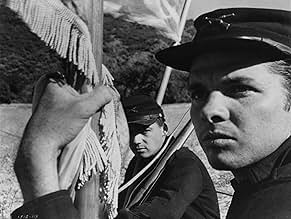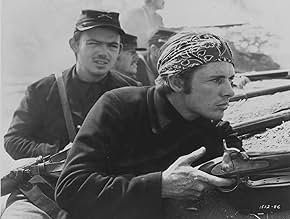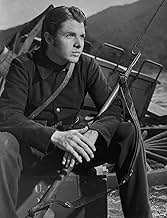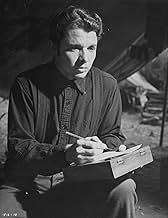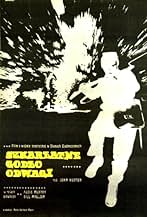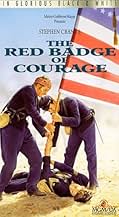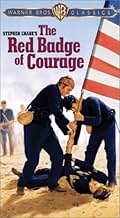Um jovem recruta encara os horrores da Guerra Civil, vacilando entre a vontade de lutar e a covardia. Depois de seu primeiro combate, o jovem foge, mas o sentimento de vergonha o leva de vol... Ler tudoUm jovem recruta encara os horrores da Guerra Civil, vacilando entre a vontade de lutar e a covardia. Depois de seu primeiro combate, o jovem foge, mas o sentimento de vergonha o leva de volta à sua unidade.Um jovem recruta encara os horrores da Guerra Civil, vacilando entre a vontade de lutar e a covardia. Depois de seu primeiro combate, o jovem foge, mas o sentimento de vergonha o leva de volta à sua unidade.
- Direção
- Roteiristas
- Artistas
- Indicado para 1 prêmio BAFTA
- 2 vitórias e 1 indicação no total
- Thompson
- (as Robert Easton Burke)
- Soldier
- (não creditado)
- Union Captain
- (não creditado)
- Union Soldier Fording River
- (não creditado)
- Soldier
- (não creditado)
- Wounded Officer
- (não creditado)
- Soldier
- (não creditado)
- Wounded Soldier
- (não creditado)
- Confederate Flag Bearer
- (não creditado)
- Soldier
- (não creditado)
- Direção
- Roteiristas
- Elenco e equipe completos
- Produção, bilheteria e muito mais no IMDbPro
Avaliações em destaque
It's an examination of courage among men under intense fire--such as the infantry men in the Civil War, about whom writer Stephen Crane wrote with almost poetical finesse. So that some of Crane's writing is maintained on screen, we get a narration by James Whitmore that succeeds in helping us understand the central character (AUDIE MURPHY) and his motivations.
Judging from photographs of the Civil War, the film has a gritty, realistic look as it goes from battle to battle with a group of men we get to know and recognize as vulnerable human beings caught in the tragedy of impossible battle situations.
AUDIE MURPHY is not noted for being an actor capable of deep characterization, but he's been guided by Huston to give a very effective, deeply felt performance, no doubt helped by the fact that he's been in the midst of battle before (he's a real life war hero), and must know the inner conflicts that face any man in battle.
The supporting cast of actors are fine, especially BILL MAULDIN as Audie's friend, both of them confessing moments of cowardice during battle fatigue and then able to go on with their mission.
But the real credit has to go to John Huston for writing and directing a film that he was never especially proud of, but which is stunningly photographed and directed with great skill.
The Red Badge of Courage refers to the blood that gets spilled should you sustain a battle wound. If you remember in Oliver Stone's Platoon, the men don't treat new arrival Charlie Sheen until he's gotten one of those. Here the Red Badge is something to be avoided if possible.
By a piece of serendipity when Audie Murphy returned from World War II and was deciding on a career, he chose the movies. He certainly was loaded down with offers, but I guess he sensed in himself an inner gift for being an actor. Not Marlon Brando or Laurence Olivier, but someone in the hands of the right director could get a good performance out of him. In John Huston he found that director, twice in fact as he later worked with him in The Unforgiven.
There was no need for research because our most decorated soldier in history lived the research in North Africa and Europe. There's a dimension to Audie's performance and that of GI cartoonist Willard Mullin that no training at the Actor's Studio could have given them. Murphy just summoned his memories of what it was like to be a kid from Texas whisked off to Europe the way young Henry Fleming is facing the Confederates in their backyard.
Murphy gets good support from an able cast of people like Arthur Hunnicutt, Royal Dano, John Dierkes, and Andy Devine as various other soldiers in the Union Army, all citizens serving their country. No career people in this crowd. Also James Whitmore, reading the narrative of Stephen Crane's novel serves almost like another cast member and moves the film's story line along.
Though it lost money for MGM, The Red Badge of Courage is still a fine film with some great insights into the meaning of battlefield bravery.
The somewhat amateur cast is outstanding. I expect the untrained Murphy felt a personal commitment to his role and comes through just as professionally as he did in real life. Untrained cartoonist Bill Mauldin also looks and acts the part of callow youth maturing under pressures of life or death situations. His big ears are especially persuasive for a Hollywood setting.
And what burst of inspiration led the normally glamor-obsessed Tiffany of Studios to cast such affecting unlovelies as John Dierkes and Royal Dano in key parts. It's Dierkes's ill-fated salt-of-the-earth soldier that injects real tragedy into the sparse dialogue. With his craggy face and towering body he's every inch the early American primitive. And, of course, there's Dano with his gaunt face, wasted body, and graveyard voice, who helps make that line of wounded soldiers (the real core of the film) an unforgettable procession. Nor should that genuine face of war, the battle-shocked soldier deliriously bellowing The Battle Hymn of the Republic as he trudges along, be overlooked. And for a little humorous relief, who can forget the general whose pep-talk to each unit sounds like a broken record with a big stomach, but whose humanity shines through anyway.
The sweeping battlefields are effective in their look and feel, even if it is the scrublands of SoCal in the distance. Note all the dust and smoke obscuring vision, along with the chaotic criss-crossing of other units going here and there, but we don't know where. The effect is that of focusing our concerns on the familiar faces rather than on who's winning or losing the battle, which, I gather, is the way most infantry experience battle. It's been called understandably "the fog of war".
I like the brief lyrical moments that remind us of a larger world outside the stage of human conflict. Actually, Murphy is quite good at portraying sensitivity, as for example when he turns away from the raucous byplay at the farm house. The quiet moments with him and Mauldin are rather touching in that they look like two average Joe's showing the personal side of war. But, as Murphy proved in both the movie and real life, you never know the depths that may be concealed under that ordinary appearance.
I believe it was critic Andrew Sarris who pointed out that John Huston's career was never the same after MGM got through editing out an hour of his version and throwing the rest away. Now we can only guess how many other affecting scenes were tossed out in the process. Obviously, the project was close to Huston's heart being an adaptation of a great American novel from its most wrenching national conflict. I don't know whether to be happy or sad that this severely truncated version was finally marketed. It's good, but then there's the promise of so much more. Too bad the production didn't migrate to a less image-conscious studio.
Você sabia?
- CuriosidadesAfter seeing what MGM had done to the film, John Huston instructed his agent to include a clause in all future contracts guaranteeing that he would receive a copy of his director's cut on all of his films.
- Erros de gravaçãoBeginning at 14:28, several Union soldiers wading across the waist-deep river and later climbing out of the river are carrying the U.S. Rifle Model 1903, also known as the Springfield Model 1903. Note especially the soldier who climbs out of the river holding his rifle above his head. The Model 1903 is a bolt-action, magazine-fed rifle that was adopted by the US Army in 1903 and used in World Wars I and II, but not the American Civil War which was fought from 1861-1865.
- Citações
The General: Howdy Jim, Corporal. How are those wounds?
Soldier: Stinging some, General, but they're a-mending.
The General: That's fine, fine. Anybody care for a chaw?
- ConexõesEdited into Hollywood: The Dream Factory (1972)
Principais escolhas
- How long is The Red Badge of Courage?Fornecido pela Alexa
Detalhes
Bilheteria
- Orçamento
- US$ 1.640.000 (estimativa)
- Tempo de duração
- 1 h 9 min(69 min)
- Cor
- Proporção
- 1.37 : 1


